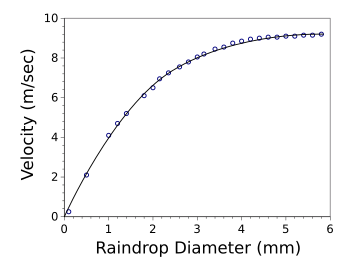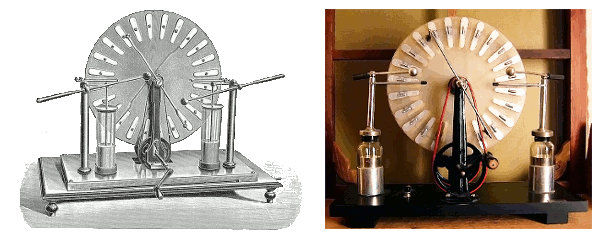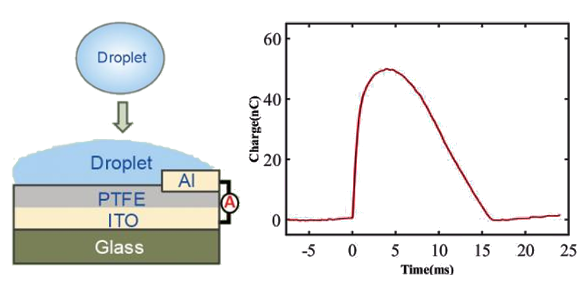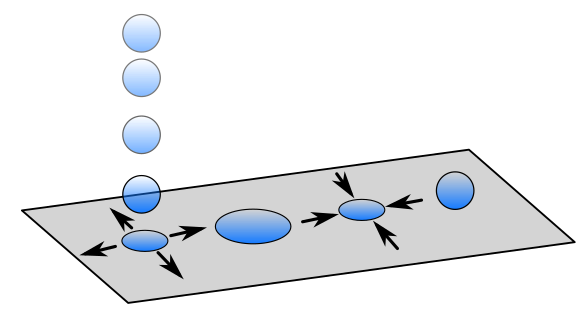Raindrop Energy-Harvesting
October 5, 2020
I've maintained a huge collection of
music CDs, started with the introduction of the
CD format in the early
1980s. I had even heard a demonstration of a
microwave oven sized
prototype CD player at a
meeting of the
Audio Engineering Society in
New York City a few years prior. While I still have a working CD player, it's now rare for me to listen to any of my collection, since presently there are easier ways to hear most of this music. For example, I have a CD of
Steve Reich's Music for 18 Musicians, but I can now view the piece as a performance on
YouTube.[1]
One of my other CDs is a
soundtrack recording of
The Magnificent Seven (
John Sturges,
Director, 1960),[2]
composed by
Elmer Bernstein. Bernstein's
score for this
Western incorporated many elements of the
nostalgic Americana musical themes of
Aaron Copland. Another popular western movie, produced nearly a
decade later, was
Butch Cassidy and the Sundance Kid (1969,
George Roy Hill, Director),[3] which had an
incongruous comedy relief sequence involving the
Hal David and
Burt Bacharach song, "
Raindrops Keep Fallin' on My Head."

The terrestrial water cycle. (USGS image by John Evans and Howard Periman, via Wikimedia Commons. Click for larger and more detailed image.)
As can be expected for a
planet whose
surface is covered 71% by
water,
rainfall is a frequent occurrence in most areas. We should be thankful for our planet's
water cycle, as illustrated in the above figure, that distributes water across
Earth's land areas to create our plentiful
vegetation. Our
civilization was created by water through
agriculture. In today's world, civilization is propelled by
energy, and we get some of this energy through water by
hydroelectric power.
Frequent
power outages, like the week-long August, 2020,
electrical power outage that
Tikalon experienced as a consequence of
Hurricane Isaias, reminds us that
centralized power generation has its problems. Tikalon's power was maintained through this outage by local generation provided by a
natural gas electrical generator installed years ago after frustration with repeated power outages in our
suburban location. Since
torrential rain is the cause of so many power outages, it's
ironic that
raindrops have been used as an energy source. I've written two earlier articles about some techniques for raindrop
energy harvesting (
Pyroelectric Energy Harvesting, October 15, 2010, and
Power from Raindrops, March 23, 2020).
Just how much energy is contained in a raindrop? It's a simple
calculation, since
falling bodies in
air achieve a
terminal velocity Vt that depends on their
mass and
cross-sectional area.

where
m is the mass of the raindrop (which can be calculated from the
density of water and the
diameter of the presumed
spherical droplet),
g is the
gravitational acceleration,
Cd is the
drag coefficient (in this case, about 0.5),
ρ is the
density of air, and
A is the
projected area of the raindrop (also calculated from the droplet diameter). This
equation ignores the small
buoyancy of the droplets in air. Once we have the velocity, we can apply the
(1/2)mv2 kinetic energy equation to obtain the droplet energy.
Statistics about droplet size and rainfall
rates will give the
maximum harvestable raindrop energy over an
area.

Raindrop velocity as a function of diameter.
The curve is an aid for the eye, and it isn't a function fit.
(Graphed using Gnumeric from data from Wikimedia Commons image by Janusz Dorożyński. Click for larger image.)
Theory reveals the possibilities, but it takes actual
experiments to see how much raindrop energy can be converted into useful
electricity. There are two principal
phenomena that accomplish the task to
conversion of
impact energy into electrical energy; namely, the
piezoelectric effect, and the
triboelectric effect. In the piezoelectric effect, certain
crystalline and
polycrystalline solids will produce
electrical charges at their surface in response to an applied
Mechanical stress. In the triboelectric effect,
rubbing, and then separating,
dissimilar materials produces a charge difference between them.
Static electricity is an example of triboelectricity.

The Wimshurst machine was a device for harvesting triboelectricity. It appeared as a prop in classic Frankenstein films. Left image, a scan by Andy Dingley from the 1903, Electrical Installations (Volumes V) by Rankin Kennedy, Caxton Press, London. Right image, a modern replica. Images from Wikimedia Commons)
in 2008,
scientists at the
French Atomic Energy Commission (Commissariat à l'énergie atomique, Grenoble, France), extracted raindrop energy using a sheet of the piezoelectric material,
polyvinylidene fluoride.[4-5] They showed that the raindrops found in
drizzle (one
millimeter diameter) produce an impact energy of two
microjoules, and the five millimeter droplets of a heavy rain have a millijoule of energy.[4-5] Huge raindrops were detected that had more than ten millijoules of energy.[4-5] They calculated that rainfall in
France would produce an
average power of about one
watt-hour per
square meter.[4] The energy-harvesting was aided by the fact that most raindrops impact
inelastically; that is, they don't bounce.[4-5]
Just this year, a team of scientists from
China and the
University of Nebraska-Lincoln (Lincoln, Nebraska) published in
Nature details of a triboelectric raindrop energy harvester.[6-7] Their device,whose
architecture is similar to that of a
field-effect transistor, consists of a
polytetrafluoroethylene (PTFE, Teflon)
film on an
indium tin oxide (ITO) substrate with an
aluminum electrode (see figure).[6] A falling water drop will spread over the surface of the device to bridge the electrodes to release the developed
electrical charge.[6]

Schematic diagram of the droplet-based electrical generator and temporal evolution of charge after droplet impact and subsequent spreading. Impact of water droplets on the PTFE generates surface charges that are conducted by the spreading water droplet to the aluminum electrode. (Left. a City University of Hong Kong image. Right, a still image from a City University of Hong Kong video.)
While the triboelectric raindrop energy harvester is more
expensive to make than polyvinylidene fluoride piezoelectric devices, its performance is impressive. The instantaneous
power density of this device is as high as 50.1
W/m2.[7] As
Zhong Lin Wang, an
author of the paper and a member of the
Chinese Academy of Sciences, explains, "Our
research shows that a drop of 100
microliters (1 microliter = one-millionth
liter) of water released from a
height of 15
cm can generate a
voltage of over 140V. And the power generated can light up 100 small
LED light bulbs."[7] I
published a short
article on a triboelectric effect device in 2016.[8]
Members of this original research team from the
South China Normal University (Guangzhou, PRC) have teamed with scientists from the
University of Twente (Enschede, The Netherlands) in continued
development of this energy harvesting concept and publishing their research in a recent issue of
Physical Review Letters.[9-10]
This
nanogenerator is based on the combined effects of triboelectricity and
hydrophobicity has no
moving parts, aside from water
flow, and it's very
efficient.[10] Water droplets impact an upper
film of polytetrafluoroethylene (PTFE, Teflon) on a conducting plate. Impact of the droplet develops a
negative charge on the PTFE film paired with a
positive charge on the conductive plate, effectively forming a charged
capacitor. Impact of each droplet adds to the capacitor charge that subsequently can be used as a source of electrical energy.[9-10]
Power is extracted from the capacitor by the droplets themselves, since a spreading droplet temporarily connects the charged surface to an electrode.[9-10] But that's not the end of the story. Hydrophobicity causes the impacted droplet to subsequently bead, and this automatically recharges the capacitor after each discharge (see figure).[9-10]

Evolution of water droplet shape on the hydrophobic surface of the triboelectric energy-harvester. (Created using Inkscape.)
As
Siddharth Rajupet and
Daniel J. Lacks of
Case Western Reserve University (Cleveland, Ohio) Department of Chemical and Biomolecular Engineering observe in their
commentary on this paper, the
mechanism of triboelectricity is still unknown, as is the reason why some pairs of
materials make better
triboelectric couples than others.[10] In particular, it's not understood how rubbing is important. It might serve to increase the
contact area, or it might serve to
cleave charge carriers from one surface to the other.[10]
References:
- Steve Reich, "Music for 18 Musicians," Full Performance with eighth blackbird, YouTube Video by Vic Firth, September 28, 2012. For purists, an audio performance with Steve Reich on Piano and Marimba, recorded live for French radio on October 22, 1976, can be found also on YouTube, here.
- The Magnificent Seven (1960, John Sturges, Director) on the Internet Movie Database
- Butch Cassidy and the Sundance Kid (1969, George Roy Hill, Director) on the Internet Movie Database
- Romain Guigon, Jean-Jacques Chaillout, Thomas Jager and Ghislain Despesse, "Harvesting raindrop energy: experimental study," Smart Materials and Structures, vol. 17, no. 1 (January 11, 2008), Article no. 015039, https://doi.org/10.1088/0964-1726/17/01/015039.
- Lisa Zyga, "Rain Power: Harvesting Energy from the Sky" (PhysOrg, January 22, 2008).
- Wanghuai Xu, Huanxi Zheng, Yuan Liu, Xiaofeng Zhou, Chao Zhang, Yuxin Song, Xu Deng, Michael Leung, Zhengbao Yang, Ronald X. Xu, Zhong Lin Wang, Xiao Cheng Zeng, and Zuankai Wang, "A droplet-based electricity generator with high instantaneous power density," Nature (February 5, 2020), https://doi.org/10.1038/s41586-020-1985-6.
- New droplet-based electricity generator: A drop of water generates 140V power, lighting up 100 LED bulbs, City University of Hong Kong Press Release, February 5, 2020.
- D.M. Gualtieri, "Simple, Novel Switch Exploits Triboelectric Effect," Electronic Design, June 3, 2016.
- Hao Wu, Niels Mendel, Dirk van den Ende, Guofu Zhou, and Frieder Mugele, "Energy Harvesting from Drops Impacting onto Charged Surfaces," Phys. Rev. Lett., vol. 125, no. 7 (August 14, 2020), Article no. 078301, https://doi.org/10.1103/PhysRevLett.125.078301. I was able to access a PDF file here, and a version appears at arXiv here.
- Siddharth Rajupet and Daniel J. Lacks, "Harvesting Energy from Falling Droplets," Physics, vol. 13, no. 125 (August 12, 2020).
Linked Keywords: Optical audio disc; music CD; CD format; 1980s; microwave oven; prototype; academic conference; meeting; Audio Engineering Society; New York City; Steve Reich; Music for 18 Musicians; YouTube; soundtrack recording; The Magnificent Seven; John Sturges; Director; composer; composed; Elmer Bernstein; musical score; Western (genre); nostalgia; nostalgic; Americana; subject (music); musical theme; Aaron Copland; decade; Butch Cassidy and the Sundance Kid; George Roy Hill; congruence; incongruous; comic relief; comedy relief; Hal David; Burt Bacharach; Raindrops Keep Fallin' on My Head; terrestrial; water cycle; USGS; Wikimedia Commons; planet; topography; surface; water; rainfall; Earth; lithosphere; land area; vegetation; civilization; agriculture; energy; hydroelectricity; hydroelectric power; power outage; electricity; electrical; Tikalon; Hurricane Isaias; electric power transmission; centralized power generation; natural gas; electric generator; suburb; suburban; torrent; torrential; rain<; irony; ironic; raindrop; energy harvesting; calculation; equations for a falling body; falling body; atmosphere of Earth; air; terminal velocity; mass; cross section (geometry); cross-sectional area; density of water; diameter; sphere; spherical; gravitational acceleration; drag coefficient; density of air; projected area; equation; buoyancy; kinetic energy; statistics; frequency; rate; maximum; area; velocity; function (mathematics); curve; curve fitting; function fit; Gnumeric; data; Janusz Dorożyński; theory; experiment; phenomenon; phenomena; energy transformation; energy conversion; impact (mechanics); piezoelectricity; piezoelectric effect; triboelectric effect; crystal; crystalline; polycrystal; polycrystalline; solid; electric charge; electrical charge; stress (mechanics); mechanical stress; rub; rubbing; triboelectric series; dissimilar materials; static electricity; Wimshurst machine; device; energy harvesting; triboelectricity; theatrical property; prop; classic; Frankenstein; Andy Dingley; scientist; French Atomic Energy Commission; polyvinylidene fluoride; drizzle; millimeter; joule; microjoule; France; average; electric power; kilowatt hour; watt-hour; square meter; inelastic collision; People's Republic of China; University of Nebraska-Lincoln (Lincoln, Nebraska); Nature (journal); architecture; field-effect transistor; polytetrafluoroethylene; PTFE; coating; film; indium tin oxide (ITO); substrate (electronics); aluminum; electrode; schematic diagram; drop (liquid); electric generator; time; temporal evolution; impact (mechanics); surface charge; electrical conductor; conduct; City University of Hong Kong; cost; expensive; power density; surface power density; W/m2; Zhong Lin Wang; author; Chinese Academy of Sciences; research; liter; microliter; altitude; height; centimeter; cm; voltage; light-emitting diode; LED; LED lamp; light bulb; publication; publish; scientific literature; article; South China Normal University (Guangzhou, PRC); University of Twente (Enschede, The Netherlands); research and development; Physical Review Letters; nanogenerator; hydrophobe; hydrophobicity; moving part; fluid dynamics; flow; energy conversion efficiency; efficient; negative charge; positive charge; capacitor; process; shape (geometry); surface; Inkscape; Siddharth Rajupet; Daniel J. Lacks; Case Western Reserve University (Cleveland, Ohio); Department of Chemical and Biomolecular Engineering; opinion piece; commentary; physical mmechanism; material; triboelectric couple; contact area; cleave.